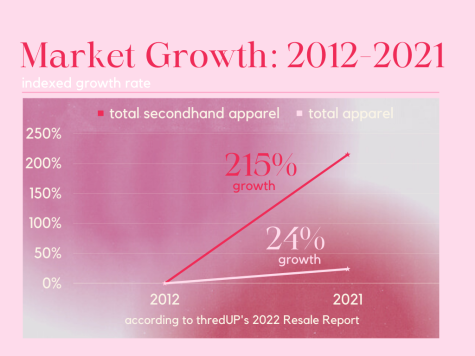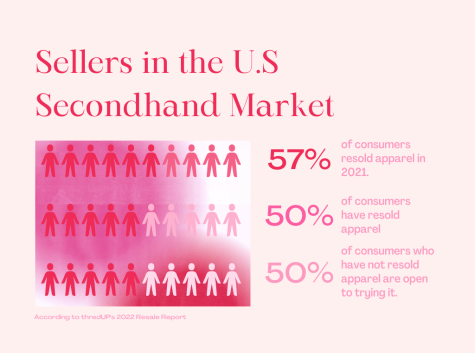As thrifting clothing has become increasingly popular, people have turned to selling secondhand items online.
Secondhand clothing has been on the rise in recent years in the United States, leading to the growth of online clothing reselling apps such as Depop, Vinted, Grailed, Poshmark, and thredUP. According to thredUP’s 2022 Resale Report, the U.S. secondhand market is expected to more than double by 2026, reaching $82 billion.
Driven by a desire to live more sustainably, many have turned to thrifting for clothes. Thrifting refers to buying secondhand clothing from thrift centers, vintage shops, or wholesale warehouses instead of purchasing from retail companies.
While some people thrift out of necessity for the low prices, others do so as a way to stop supporting fast-fashion companies in their destructive practices towards their garment workers and the planet.
Some individuals have taken advantage of such consumer behavior and have started personal businesses. These sellers list their items through apps or on their websites, and once their listings are sold, they ship orders out to the buyers’ homes. This process of clothing getting bought, donated, and resold for a profit can be recognized as a circular business practice.

“Not only can more circular business practices cut emissions, reduce primary resource use, minimize waste, and create a more accessible economy for all, but the growth of circular systems shows many recognize this can be a winning business formula, too,” said Susan Harris, the technical director of the Anthesis group.
Many sellers started their businesses because of their interest in fashion and their knack for thrifting.
“When you’re going thrifting, it’s pretty difficult to pick out good pieces. Some people go thrifting and don’t find much. But because of my business, I shop for different styles and sizes of clothing, not just for myself. This broadens what I look for and what I purchase. But really, a lot of it is just luck and looking in the right places; sometimes it even depends on your location,” said Kate Teasdale, a verified seller on Depop based in St. Louis, Missouri.
Teasdale, whose @kat_teasdale account has 17K followers and has made over 630 sales through Depop since the 2020 COVID-19 Pandemic, had previously only used the app as a buyer. She found that some of the pieces she had ordered did not end up fitting her and decided to resell them on Depop.
“At first, I started selling on the app just to get rid of those items. I wasn’t buying things just to resell them, but sometimes I would get a pair of jeans, and they would not fit me correctly. I really did not expect to get verified on the app later on when I started making a lot of listings,” Teasdale said.

Joshua Lisi, a junior at Carlmont High School, wanted to start his own clothing business called Leezy Studios, which sold pieces to push buyers to expand their styles, finding his clothes at the Goodwill Wholesale Warehouse.
In contrast to other Goodwill thrift stores or Salvation Armies, the wholesale facility houses large bins of unsold items from traditional thrift centers that are then sold at discounted, by-the-pound rates. These warehouses are the last stop for the clothing before unsold items are sent to the landfill. The large bins are filled to the brim, with merchandise getting rotated throughout the day to keep an incoming supply of clothes.
“I go with a group of friends and sift through the piles of clothing. I check for any damages, such as rips or too much wear, and then I think of ways that I would style it. If I can come up with something cool in my head, I choose to sell it on my site,” Lisi said.
When sorting through such large quantities of clothing, sellers must create their own criteria for what they think will sell in their online shops.
Teasdale also primarily sources her clothing from the Goodwill Wholesale Warehouses for her shop. When searching for pieces to sell, she is sure to look at the material and condition of the item.
“When you buy something online, you really don’t know the quality of the item. It can be pretty disappointing when you receive something of poor quality or that you can tell has been drop shipped by the seller,” Teasdale said. “I look at the material tag to see if it’s a well-made garment. I don’t just choose an item because of its brand, but mostly because of its style or texture.”
Sellers must price their items according to demand, popularity, brand, or material. On Teasdale’s Depop, her average listings are around $25 to $28.
“Depop often gets a bad reputation because of price-gougers. I don’t want to overprice my items out of respect for the buyer and because I just don’t see the need to do so,” Teasdale said.
Lisi shares a similar profit margin and pricing strategy, which relies on wholesale warehouses’ cheaper, by-the-pound pricings. This model allows him to have to only allocate money for advertising and website upkeep because, at the warehouses, a shirt usually only costs around 5 to 10 cents. The low cost of acquiring their clothing allows secondhand sellers to make profits.
“Profit is not the sole driving factor for my business,” said Lisi. “What I would love is to sell cool pieces that inspire people to be confident in what they wear and feel comfortable doing so.”












